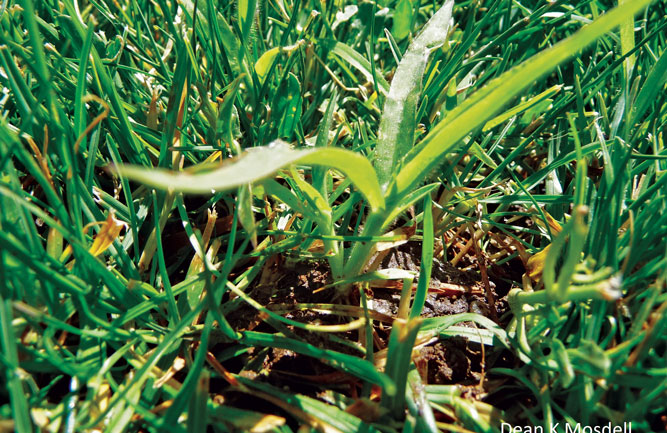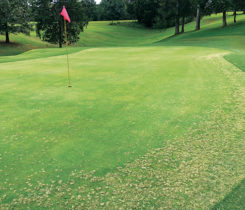Topramezone and Chelated Iron for Goosegrass Control
Goosegrass (Eleusine indica) is one of the most problematic grassy weeds of turfgrass. Management can be difficult because of goosegrasses’ ability to thrive in extreme environments and the lack of available post emergent herbicides offering acceptable control.
Monosodium methanearsonate (MSMA) was a primary post emergent herbicide used for goosegrass control in warm-season turfgrasses until 2009, after which the EPA heavily restricted its use in the turfgrass industry. Previous research has shown that topramezone (Pylex, BASF) offers excellent postemergent control of goosegrass and potentially could add to the diminishing list of available herbicides.

Examples of heavy goosegrass infestation before Pylex plus chelated iron application (left), and three weeks after application.
Just as with other HPPD inhibitors, turfgrass injury can be an issue. Pylex affects the carotenoid biosynthesis pathway, causing leaf bleaching in warm-season turfgrasses. Previous research conducted at Auburn University in 2015 and 2016 indicated that Pylex used in combination with chelated iron significantly reduced the bleaching effects on bermudagrass (Cynodon dactylon).
Greenhouse trials were conducted to determine whether the addition of chelated iron affected Pylex efficacy for goosegrass control. Two rates of Pylex (0.25 and 0.5 fl. oz. /A), five rates of chelated iron (0.5, 1, 2, 4 and 8 oz. /1,000 sq. ft.), and MSO (0.5% v/v) were mixed in all possible combinations and applied sequentially (initial, three weeks after initial) to two goosegrass biotypes.
The results of the trials showed that both rates of Pylex, with or without the addition of chelated iron, yielded complete control of both goosegrass populations for all treatments in both greenhouse trials. Our data suggest that the combination of chelated iron and Pylex may offer another herbicide option for goosegrass control in bermudagrass. Turfgrass managers should consider this herbicide to combat future issues with goosegrass resistance.
Adam Boyd and Scott McElroy, Ph.D., are at Auburn University, Auburn, Ala. Contact Adam with questions at apb0036@auburn.edu.
Photo by: Adam Boyd











